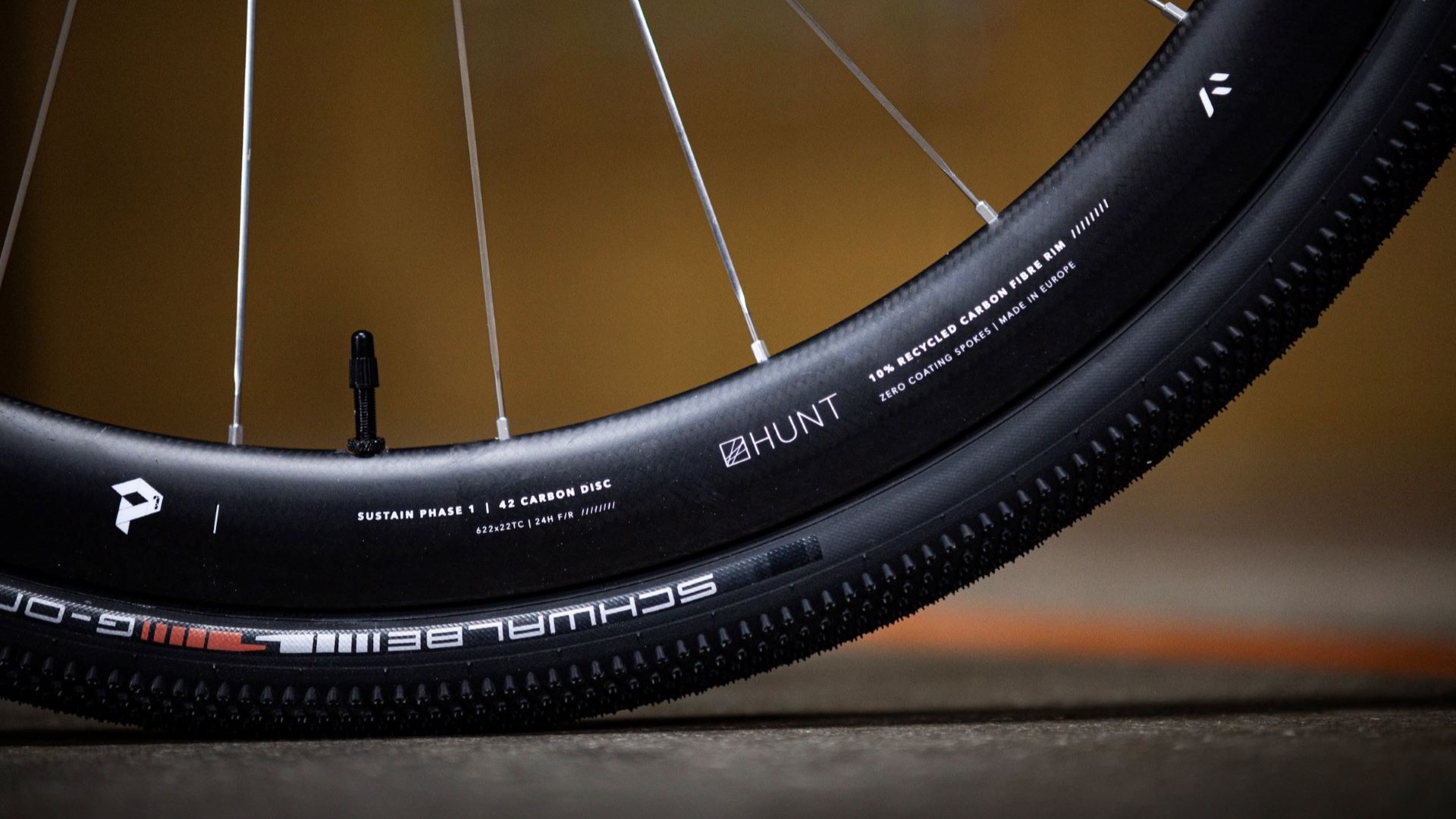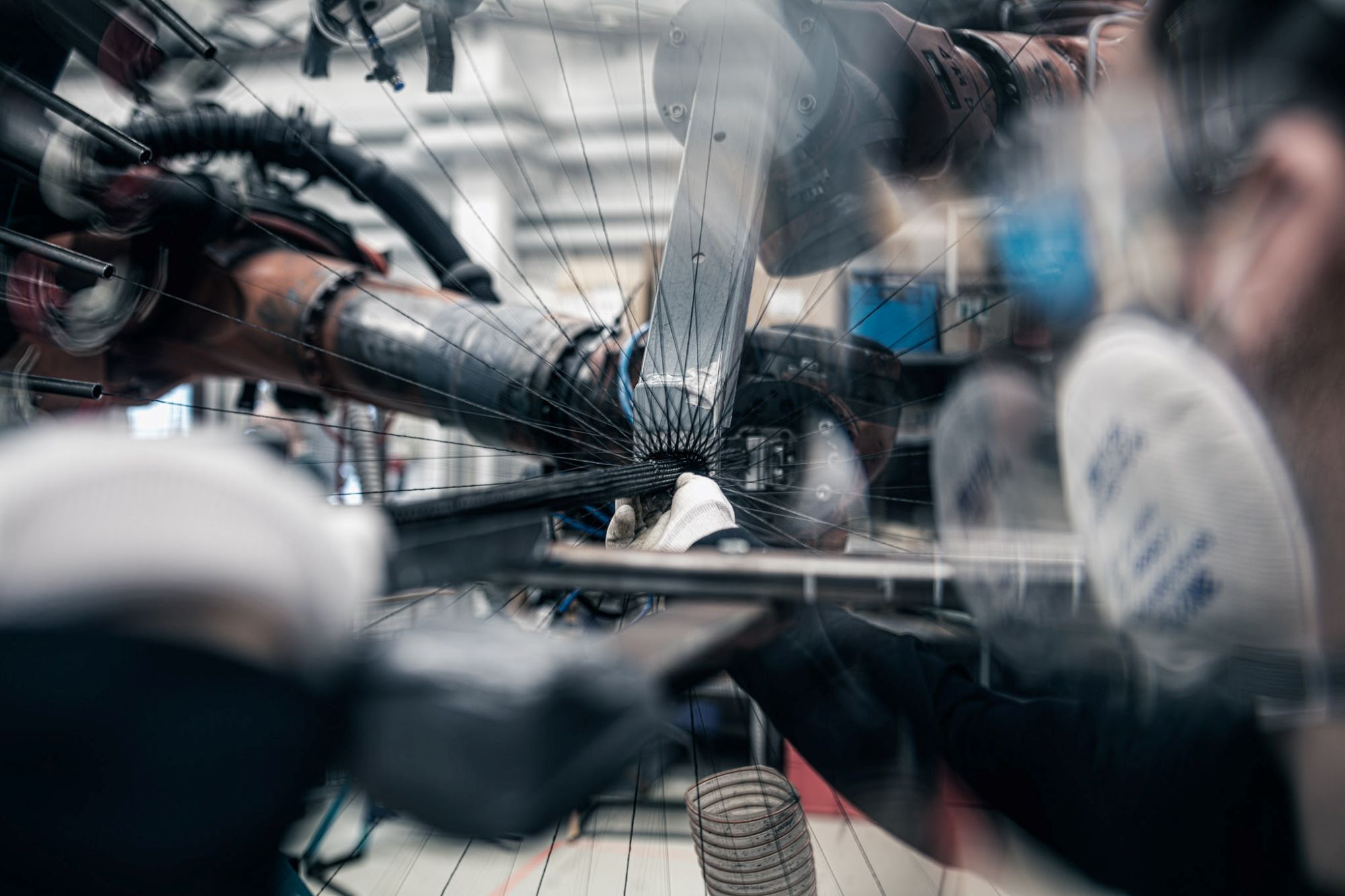Hunt Bike Wheels’ recent moves towards sustainability are more meaningful than you think
Subtle first Steps, big long-term commitment


For many, the notable takeaway from Hunt’s recent announcement about adding a sustainability angle to their wheel program was that they’re going from black to paint-less silver spokes on a few models. Big deal, right?
The UK brand’s efforts might sound lackluster when compared to what companies like Forge and Bond are doing with their line of 100% recyclable, zero-waste thermoplastic wheels. But you’d be wrong to assume that Hunt’s moves—which indeed do include more than just silver spokes—aren’t meaningful ones in the effort to address climate change.
The first of several planned steps to adapt their line of high performance carbon and aluminum wheels for sustainability will include updated manufacturing processes and material specs for their three most popular wheel models–the first of what will now be call the Sustain Phase One range–intended to gather more information about rider preferences and the prioritization of sustainability through their purchase decisions and feedback.
For the 42 Carbon Disc Ti model, mold bladders will go from one-time-use silicone bladder to a wax mold/bladder/insert system which can be reused 25 times. A new polycarbonate tire bed mold will produce higher levels of accuracy and repeatability of tire bed dimensions compared to what the prior silicone mandrel yielded, resulting in a lower overall scrap rate. Hunt also revised how they manage raw material to eliminate the need for prolonged refrigeration, and carbon itself now incorporates 10% reclaimed trim material from aerospace and automotive industries.
Their aluminum 4 Season All Road Disc and Trail Wide 29 models will use 75% reclaimed material for the rims. All three models will incorporate the aforementioned uncoated silver spokes, foregoing the energy and chemicals required for black spokes. It’s also worth noting that from their inception, Hunt has developed products with long term support in mind, including interchangeable components and spare parts stocked back to their earliest models, to maximize product lifespan.
These are the first and most consumer-visible steps in a much larger process outlined by the Science Based Targets Initiative (SBTi), a collective global collaboration between the United Nations Global Compact, World Resources institute and WorldWide Fund for Nature which aims to define a path to reduce greenhouse gas emissions in accordance with the Paris Agreement. This agreement, or treaty, was adopted by 196 sovereign states in December, 2015, with a primary goal of limiting global warming to well below 2 degrees Celsius. And this is the bigger story.

From the SBTi site:
Get The Leadout Newsletter
The latest race content, interviews, features, reviews and expert buying guides, direct to your inbox!
The SBTi’s Corporate Net-Zero Standard is the world’s only framework for corporate net-zero target setting in line with climate science. It includes the guidance, criteria, and recommendations companies need to set science-based net-zero targets consistent with limiting global temperature rise to 1.5°C.
Net-zero pledges now cover 92% of GDP and 88% of emissions worldwide. Despite this, the definition of net-zero and the path to get there has been interpreted in different and inconsistent ways.
Without a common definition, targets can differ in terms of the emissions sources included and the depth and speed of emissions reductions. This has fuelled confusion and accusations of greenwashing.
The SBTi’s Corporate Net-Zero Standard addresses this problem by providing a clear, consistent and science-based definition of net-zero. By aligning with this Standard, companies can set science-based net-zero targets to demonstrate their climate action leadership and their commitment to ensuring a habitable planet for all.
The TLDR version:
SBTi provides a scientifically-backed process for companies looking to authentically address climate change that includes a full spectrum of steps well beyond the use of recyclable or reclaimed materials, factoring more complex aspects of sustainability such as supply chain management, among many others. By embarking on the SBTi journey, Hunt sets themselves apart from brands who, well-intended or otherwise, might not be making as much progress towards sustainability as their marketing might claim.
Hunt is not the only cycling brand to embark upon the rather demanding SBTi path. They join Canyon, Trek, Thule, MIPS, global helmet factory Strategic Sports and likely others, though the shift toward science-based sustainability can’t happen overnight.
“The more complex elements, such as the use of recycled content or the resin transfer process, depend on collaboration with the wider industry to develop lower impact processes. In many cases, those processes are being developed in larger industries and adapted to the needs of bike industry applications. It has taken years, and in some cases decades, for the industry to develop recycled materials that meet the performance needs of cyclists, particularly in the area of strength-to-weight ratios,” said Ken Rodriguez-Clisham, Hunt North America Brand Manager.
It’s promising to see leading performance brands like Hunt and others taking the steps to make cycling gear as sustainable as it can be, and an even greater part of the solution in the fight against climate change.
“We feel it’s our responsibility as a small business to explore and test ways of improving the sustainability of our products and give riders the opportunity to choose more sustainably produced products within our range. We believe in the power of cycling to reduce reliance on cars, but there’s plenty of work to be done on the environmental impact of the cycling products that we all create and use. This Sustain Phase One range is just the first step, and rider feedback will help guide our future product development decisions," said Tom Marchment, Hunt Co-Founder.
For riders trying to make sustainable purchases and decisions (that’s another story TBH) it’s worth noting that the complexities of adding sustainability into a product line and company ethos extends beyond headline-grabbing materials choices and we hope to see more brands (cycling and otherwise) embrace the SBTi path.

Thank you for reading 20 articles this month* Join now for unlimited access
Enjoy your first month for just £1 / $1 / €1
*Read 5 free articles per month without a subscription

Join now for unlimited access
Try first month for just £1 / $1 / €1

Sean Coffey started out as a Northern California road racer and bike shop rat in the late 1980’s. In the three decades since, he’s used his journalism degree and technical cycling knowledge to wedge himself into a variety of marketing, editorial and product roles at several iconic cycling brands. Now residing in the 2015 UCI Road Worlds host city of Richmond Virginia with his wife, cats and an absurd quantity of bikes, Coffey prefers the sort of steep and miserable climbs others dread, actually looks forward to intervals, takes Strava KOM’s maybe a bit too seriously and will never stop racing cyclocross.
-
 Rapha launches the Super-League, a new British road racing points competition
Rapha launches the Super-League, a new British road racing points competition16 events make up the Rapha Super-League, including crits and road races, with overall winners crowned
By Adam Becket
-
 Jonas Vingegaard confirms race schedule ahead of Tour de France
Jonas Vingegaard confirms race schedule ahead of Tour de FranceDanish climber will only ride the Critérium du Dauphiné in June, but will take part in two altitude camps
By Tom Thewlis